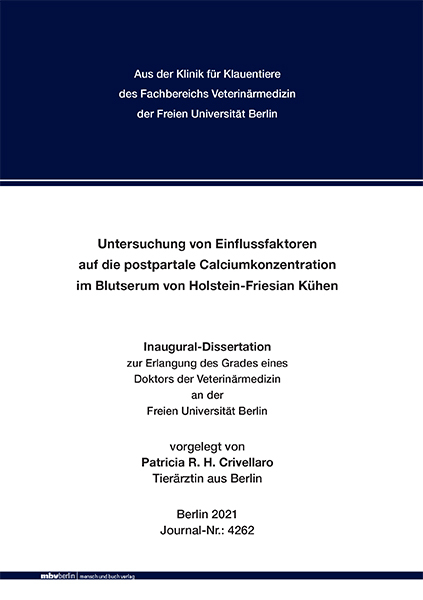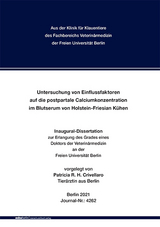Untersuchung von Einflussfaktoren auf die postpartale Calciumkonzentration im Blutserum von Holstein-Friesian Kühen
Seiten
2021
|
1. Aufl.
Mensch & Buch (Verlag)
978-3-96729-130-8 (ISBN)
Mensch & Buch (Verlag)
978-3-96729-130-8 (ISBN)
- Keine Verlagsinformationen verfügbar
- Artikel merken
Die Hypocalcämie ist immer noch mit einem hohen Risikopotential für die Kühe nach der Kalbung und mit hohen Kosten durch die Behandlung und den Folgekosten verbunden. Trotz intensiver Forschungsarbeit sind immer noch nicht alle Zusammenhänge über die Entstehung von Hypocalcämien bei Milchkühen geklärt. Als eine der häufigsten Produktionskrankheiten ist es wichtig, Ansatzpunkte zu erforschen, die eine Möglichkeit bieten, der Hypocalcämie vorzubeugen.
Dazu werden im Rahmen dieser Arbeit 109 pluripare Kühe der Rasse Holstein-Friesian im peripartalen Zeitraum betrachtet. Vor der Kalbung erfolgen die Untersuchungen ab 3 Wochen vor dem errechneten Kalbedatum montags und donnerstags um 6 Uhr im wöchentlichen Abstand. Direkt nach der Kalbung (Tag 0) findet eine Untersuchung statt und dann an den folgenden 3 Tagen täglich eine Untersuchung um 9 Uhr. Die Untersuchungen erfassen dabei den allgemeinen Gesundheitsstatus mittels einer Allgemeinuntersuchung und den Body Condition Score. Entsprechend dem Probenplan werden Blut- und Harnuntersuchungen sowie Rückenfettdickemessungen und Wägungen durchgeführt. Zusätzlich werden die Fütterungs-, Milchleistungs- und Krankheitsdaten erhoben. Die erfassten Daten werden unter Anwendung der Regressionsanalyse und dem Varianzmodell mit den Calciumkonzentrationen in Beziehung gesetzt.
Die Calciumkonzentration im Serum nach der Kalbung wird von vielen verschiedenen Faktoren signifikant beeinflusst. Vor der Kalbung hat vor allem die Laktationszahl und die Futteraufnahme am Tag 1 a.p. eine Beziehung zu der Serumcalciumkonzentration nach der Kalbung. Mit zunehmender Laktationszahl steigt das Risiko nach der Kalbung eine Hypocalcämie zu steigen. Die Futteraufnahme um die Kalbung hat einen starken Einfluss auf die Calciumkonzentration. Je höher die Futteraufnahme in diesem Zeitraum ist, desto höher ist die Calciumkonzentration im Serum nach der Kalbung.
Nach der Kalbung zeigen die Ohrtemperatur, die Pansenfüllung, die Futteraufnahme, die Calciumkonzentration, die Phosphorkonzentration und die Magnesiumkonzentration im Serum eine signifikante Korrelation mit der Calciumkonzentration im Serum p.p. Vereinzelt treten noch Zusammenhänge mit anderen Laborwerten auf. Diese sind aber nicht sehr signifikant. Wärmere Ohren und eine stärkere Pansenfüllung haben einen positiven Effekt auf eine höhere Calciumkonzentration p.p. Eine Beeinflussung durch Medikamente ist nur begrenzt möglich. Ein Zusammenhang mit der Witterung konnte nicht hergestellt werden.
Durch die geringe Variabilität der DCAB konnte in dieser Arbeit kein Zusammenhang mit der Calciumkonzentration hergestellt werden, des Weiteren wird der Einfluss durch die Fütterungselemente durch die Futteraufnahme überlagert. Die Futteraufnahme zeigt ab Tag 1 a.p. einen Zusammenhang mit den Calciumkonzentrationen im Serum.
Die Messwerte von Calcium, Phosphor und Magnesium im Serum beeinflussen die Calciumkonzentration im Serum p.p. entweder nur am selben Tag oder maximal ein Tag im Vorhinein. Dabei sind die Calciumkonzentrationen untereinander sowie mit den Phosphorkonzentrationen positiv miteinander korreliert. Im Gegensatz dazu zeigt sich zwischen den Magnesiumkonzentrationen mit den Calciumkonzentrationen eine negative Korrelation. Mittels der Parameter des roten Blutbildes a.p. und der Harnuntersuchung wird die Calciumkonzentration im Serum p.p. nicht stark beeinflusst. Investigation of influencing factors on the postpartum calcium concentration in the blood serum of Holstein-Friesian cows
Hypocalcemia still is associated with a high-risk potential for cows after calving and with high costs due to treatment and follow-up costs. Despite intensive research, not all correlations in the development of hypocalcemia in dairy cows are, yet to be clarified. Since it is one of the most frequent production diseases, it is important to explore approaches to provide a way to prevent hypocalcemia.
For this purpose, I observed 109 pluriparous Holstein-Friesian cows in the peripartal period. Before calving weekly examinations take place starting 3 weeks before the expected date of calving on Monday or Thursday at 6.00. The next examinations take places immediately after calving (day 0) an investigation occur and the following three days at 9.00. The examinations include the general health status recorded through a general examination and the body condition score. Blood and urine tests as well as back fat thickness and body weight measurements are carried out according to the sampling plan. In addition data about, the feeding, milk performance and diseases are registered. The recorded data connected with the concentrations of calcium by using the regression analysis and the variance model.
The serum calcium concentration after calving is significantly influenced by many different factors. Before calving especially the lactation number and the feed intake on day 1 a.p. have a correlation with the serum calcium concentration after calving. With increasing lactation number the risk of hypocalcemia rises after calving. Feed intake around calving has a strong influence on the calcium concentration. The higher the feed intake during this period, the higher is the serum calcium concentration after calving.
After calving, the ear temperature, rumen filling, feed intake, calcium concentration, phosphorus concentration and serum magnesium concentration show a significant correlation with the serum calcium concentration p.p. Occasionally there are correlations with other laboratory values. However, these are not or hardly significant. Warmer ears and a stronger rumen fill have a positive effect on a higher calcium concentration p.p. The influence of medication is limited and a connection with the weather could not be seen.
Due to the low variability of DCAB no correlation calcium concentration could be seen in this work. Furthermore the influence of the feeding elements is overshadowed by the feed intake. From day 1 a.p., the feed intake shows a connection with the calcium concentrations in the serum.
The measured values of calcium, phosphorus and magnesium in the serum correlates to the calcium concentration in the serum p.p. either only for one day or most one day before. The calcium concentrations are positively correlated with one another and with the phosphorus concentrations. Opposed to this, the magnesium concentration and calcium concentrations, are negativly correlatied. The calcium concentration in the serum is not affected by parameters of the haemogram and urin alysis.
Dazu werden im Rahmen dieser Arbeit 109 pluripare Kühe der Rasse Holstein-Friesian im peripartalen Zeitraum betrachtet. Vor der Kalbung erfolgen die Untersuchungen ab 3 Wochen vor dem errechneten Kalbedatum montags und donnerstags um 6 Uhr im wöchentlichen Abstand. Direkt nach der Kalbung (Tag 0) findet eine Untersuchung statt und dann an den folgenden 3 Tagen täglich eine Untersuchung um 9 Uhr. Die Untersuchungen erfassen dabei den allgemeinen Gesundheitsstatus mittels einer Allgemeinuntersuchung und den Body Condition Score. Entsprechend dem Probenplan werden Blut- und Harnuntersuchungen sowie Rückenfettdickemessungen und Wägungen durchgeführt. Zusätzlich werden die Fütterungs-, Milchleistungs- und Krankheitsdaten erhoben. Die erfassten Daten werden unter Anwendung der Regressionsanalyse und dem Varianzmodell mit den Calciumkonzentrationen in Beziehung gesetzt.
Die Calciumkonzentration im Serum nach der Kalbung wird von vielen verschiedenen Faktoren signifikant beeinflusst. Vor der Kalbung hat vor allem die Laktationszahl und die Futteraufnahme am Tag 1 a.p. eine Beziehung zu der Serumcalciumkonzentration nach der Kalbung. Mit zunehmender Laktationszahl steigt das Risiko nach der Kalbung eine Hypocalcämie zu steigen. Die Futteraufnahme um die Kalbung hat einen starken Einfluss auf die Calciumkonzentration. Je höher die Futteraufnahme in diesem Zeitraum ist, desto höher ist die Calciumkonzentration im Serum nach der Kalbung.
Nach der Kalbung zeigen die Ohrtemperatur, die Pansenfüllung, die Futteraufnahme, die Calciumkonzentration, die Phosphorkonzentration und die Magnesiumkonzentration im Serum eine signifikante Korrelation mit der Calciumkonzentration im Serum p.p. Vereinzelt treten noch Zusammenhänge mit anderen Laborwerten auf. Diese sind aber nicht sehr signifikant. Wärmere Ohren und eine stärkere Pansenfüllung haben einen positiven Effekt auf eine höhere Calciumkonzentration p.p. Eine Beeinflussung durch Medikamente ist nur begrenzt möglich. Ein Zusammenhang mit der Witterung konnte nicht hergestellt werden.
Durch die geringe Variabilität der DCAB konnte in dieser Arbeit kein Zusammenhang mit der Calciumkonzentration hergestellt werden, des Weiteren wird der Einfluss durch die Fütterungselemente durch die Futteraufnahme überlagert. Die Futteraufnahme zeigt ab Tag 1 a.p. einen Zusammenhang mit den Calciumkonzentrationen im Serum.
Die Messwerte von Calcium, Phosphor und Magnesium im Serum beeinflussen die Calciumkonzentration im Serum p.p. entweder nur am selben Tag oder maximal ein Tag im Vorhinein. Dabei sind die Calciumkonzentrationen untereinander sowie mit den Phosphorkonzentrationen positiv miteinander korreliert. Im Gegensatz dazu zeigt sich zwischen den Magnesiumkonzentrationen mit den Calciumkonzentrationen eine negative Korrelation. Mittels der Parameter des roten Blutbildes a.p. und der Harnuntersuchung wird die Calciumkonzentration im Serum p.p. nicht stark beeinflusst. Investigation of influencing factors on the postpartum calcium concentration in the blood serum of Holstein-Friesian cows
Hypocalcemia still is associated with a high-risk potential for cows after calving and with high costs due to treatment and follow-up costs. Despite intensive research, not all correlations in the development of hypocalcemia in dairy cows are, yet to be clarified. Since it is one of the most frequent production diseases, it is important to explore approaches to provide a way to prevent hypocalcemia.
For this purpose, I observed 109 pluriparous Holstein-Friesian cows in the peripartal period. Before calving weekly examinations take place starting 3 weeks before the expected date of calving on Monday or Thursday at 6.00. The next examinations take places immediately after calving (day 0) an investigation occur and the following three days at 9.00. The examinations include the general health status recorded through a general examination and the body condition score. Blood and urine tests as well as back fat thickness and body weight measurements are carried out according to the sampling plan. In addition data about, the feeding, milk performance and diseases are registered. The recorded data connected with the concentrations of calcium by using the regression analysis and the variance model.
The serum calcium concentration after calving is significantly influenced by many different factors. Before calving especially the lactation number and the feed intake on day 1 a.p. have a correlation with the serum calcium concentration after calving. With increasing lactation number the risk of hypocalcemia rises after calving. Feed intake around calving has a strong influence on the calcium concentration. The higher the feed intake during this period, the higher is the serum calcium concentration after calving.
After calving, the ear temperature, rumen filling, feed intake, calcium concentration, phosphorus concentration and serum magnesium concentration show a significant correlation with the serum calcium concentration p.p. Occasionally there are correlations with other laboratory values. However, these are not or hardly significant. Warmer ears and a stronger rumen fill have a positive effect on a higher calcium concentration p.p. The influence of medication is limited and a connection with the weather could not be seen.
Due to the low variability of DCAB no correlation calcium concentration could be seen in this work. Furthermore the influence of the feeding elements is overshadowed by the feed intake. From day 1 a.p., the feed intake shows a connection with the calcium concentrations in the serum.
The measured values of calcium, phosphorus and magnesium in the serum correlates to the calcium concentration in the serum p.p. either only for one day or most one day before. The calcium concentrations are positively correlated with one another and with the phosphorus concentrations. Opposed to this, the magnesium concentration and calcium concentrations, are negativly correlatied. The calcium concentration in the serum is not affected by parameters of the haemogram and urin alysis.
| Erscheinungsdatum | 16.12.2021 |
|---|---|
| Verlagsort | Berlin |
| Sprache | deutsch |
| Maße | 148 x 210 mm |
| Gewicht | 490 g |
| Themenwelt | Veterinärmedizin ► Allgemein |
| Veterinärmedizin ► Großtier | |
| Schlagworte | animal feeding • Animal nutrition • Birth • blood analysis • blood serum • Blutanalyse • Blutserum • body condition • body temperature • Calcium • dairy cows • Fütterung • Geburt • Haematology • Hämatologie • Holstein Friesian • Holstein-Friesian • Körperkondition • Körpertemperatur • Milchkühe • milk yield • postnatal development • postnatale Entwicklung • Urin • Urine |
| ISBN-10 | 3-96729-130-8 / 3967291308 |
| ISBN-13 | 978-3-96729-130-8 / 9783967291308 |
| Zustand | Neuware |
| Informationen gemäß Produktsicherheitsverordnung (GPSR) | |
| Haben Sie eine Frage zum Produkt? |

